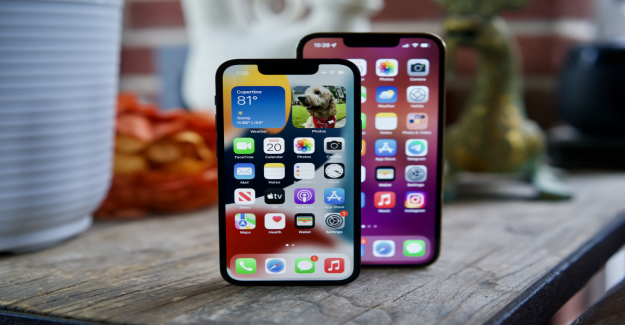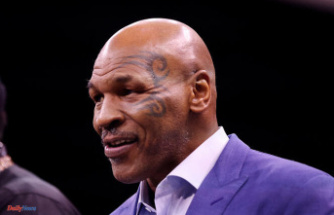We are in the third week of September and that means that a new iPhone arrives at the stores. Yes, it has passed another year, although it costs you to believe it, and with the punctuality of a solstice or an eclipse here is the new Apple phone to remind us.
They stop the rotary! Apple says that this is the best iPhone they have ever manufactured. Surprised? Already, it is understandable. It is what he says every year. And like every year, it's true. The most repeated tautology of the industry. Both the iPhone 13 and 13 mini and the iPhone 13 Pro and Pro Max are excellent.
I have been testing them for the past four days, focusing, especially on the iPhone 13 Mini and the iPhone 13 Pro. I had to choose and it's both, I think, what else they had to demonstrate this generation.
The mini because last year was short of battery. The 13 pro because his predecessor came with some cut in the camera that has forced us, to lovers of photography, to carry a very large mobile for 12 months, even though we have not been able to leave a lot of home.
They have come to redeem the sins of their predecessors and have achieved it, but they do it the way we assumed that they were going to do it. Apple usually devotes a year to great changes and another to small refinements. This year he had to refine the iPhone 12 and has been done with care and effectiveness but the result is a phone that is difficult to distinguish from his predecessors, unless you like a lot of photography and video.
The best thing is there. The kinematic mode, for example, is surprising, even despite its limitations. The cameras of the iPhone 12 have already taken great photos, but the iPhone 13 climbs the ribbon with brightest sensors, or zoom 3x and macro photography on the Pro models.
As cameras (which is what all high-end phones are, at the end of the day) fully fulfill and show that not everything is invented and that with algorithms, calculation power and ingenuity you can continue advancing even if you can not give you the Luxury from having the optics or sensor size of a SLR camera.
We go through parts ...
The iPhone 13 and 13 Pro have better screens. In the case of iPhone 13 only changes that they are now a bit brighter but in the pro, the iPhone releases the technology Promotion of variable refreshment frequency.
Many Android phones have long have 90 Hz screens, 100 Hz or 120 Hz. The figure refers to the number of times the image is updated per second. The more times it refreshes, the more fluid the animations and movements will be seen on the screen.
Apple has used this technology since 2017, but only on the iPad Pro. Now it reaches the iPhone with an intelligent system, which takes into account the content that is being displayed on the screen and adjusts the refreshment to the value that is necessary between 10 Hz and 120 Hz
This means that if we are reading a book or watching a photo, for example, the image only refreshes 10 times per second. If we are playing a game or moving on a web, you can upload until 120 times per second. If we see a movie, it will refresh 30 or 60 times per second according to the coding you have.
In general, it is one of those small details that, once you get used to it, it is difficult to ignore. Everything flows more smoothly in the interface or when it comes to scrolling on a web and everything is seen, as usual, perfect.
The variable speed also allows the iPhone to save energy, because the screen consumes much less when showing photos on Instagram or when we stop reading a paragraph on a web. It is not a huge amount (and it is compensated with the greatest consumption when it is moving content) but all the sum.
Again, this is only available in Pro models, but it is a feature that is appreciated, even though it comes with some delay.
Inside all iPhone 13 there is a new processor, the A15 Bionic. Apple, however, has not compared it as it used to make other years with the previous versions of its processors. Instead, he points out that it is 50% faster than "competition" chips.
The reason is that the A15 Bionic is something faster than the A14 Bionic, yes, but nothing spectacular. Around 10% in general calculation and something more in graphic performance. Pro models have 5 process centers in the GPU instead of 4, so they benefit something more in the comparison, although that extra nucleus is above all to support video recording in ProRes (more about this a little more down)
But some time ago to measure the figures of AX processors ceased to make sense. The A14 is still much faster than most processors of Android high-end telephones arriving these days
to the market. The A15 Bionic increases a bit that distance but at the time of truth is not something that will be noticed on the day to day.
All the power of the 6 CPU cores, 4 or 5 of GPU and 16 of the neuronal engine benefits especially to functions such as cinematic mode (more about this, also, some paragraphs below), the portrait mode or cataloging photos , by putting some examples.
Actually, despite the progress on the screen and processor, the new iPhone has a single protagonist, which is the camera module.
All iPhone have improvements in the camera this year but obviously the Pro models are the ones that benefit the most.
In the iPhone 13 changes the main camera, which is known as an angular chamber and equivalent to a traditional camera with a target of 26 mm. Now he has a sensor with the same size and stabilization system that last year equated iPhone 12 Pro Max. Even the iPhone 13 mini.
This sensor captures 47% more light and the results are excellent in most situations.
Apple has also included a new function, baptized as "photographic styles", which allows you to customize the style of capture of the images and give it more vibrant and contrasted colors or cold or warm tones.
They are not filters, but adjustments for the capture and interpretation algorithm. What is controlled, in a way, is what the camera "sees". It is configured when shooting a photo for the first time and you can change whenever you want.
For most users it is best to leave it in "Standard" mode but if we have the impression that the iPhone is firing very warm tones for our taste, or images are very flat, now you can change without having to edit photo by photo and respecting skin tones and other elements that a filter or a further adjustment to shooting would modify.
There are also improvements in Night and Deep Fusion mode (the combination of several exposures to have greater sharpness), which now work with all cameras. Smarthdr has also improved, the high dynamic range capture, which now takes into account the skin tonality settings for each of the people present in the image.
In general, what was said. The photos of the iPhone 12 were very good. Those of the iphone 13 are better in small details and much sharper in scenes with low light, such as the interior of a restaurant, thanks to the larger sensor.
In the iPhone Pro there is also a sensor with a telephoto optics, which this year is more powerful. It offers an increase of 3x and is equivalent to 77 mm. In traditional photography, which is a more classical perspective for portrait.
The jump causes the distance that separates the angle of the telephoto cribs, and therefore it is necessary to resort to higher digital zoom for the interval between 1x (26 mm.) And 3x (77mm.) Increase, but in general the quality It remains homogeneous along the zoom rank, partly because Apple can now expose the images something more than time thanks to the stabilized optic and work plus the final aspect of the image thanks to the processor A15.
Going to 3x, however, it supposes to lose some luminosity in the telephoto camera. The 3x lens has an opening of F / 2.8, which captures less light than the 2,5x or 2x camera of the iPhone 12 Pro and 12 Pro Max. When there is little light, it is easier for the phone to resort to the angular camera and cut the image before using the telephoto lens, which is not only less sensitive but is not stabilized either. You can force the use of the lens with specialized photography app in these extreme cases, but the result will be something more noisy and blurred than desirable.
In general, if you do many pictures of portrait or want the greatest possible versatility, the iphone 13 PRO deserves certainly the penalty, but the quality of all iPhone 13, including the mini, is good and, this year, who choose the pro They will not have to sacrifice anything if they choose the most compact model instead of Pro Max. They have exactly the same camera module.
The main sensor and the telephoto is not the only one that improves. All this year's iPhone has a new ultra-wide-angle sensor (Apple calls 0,5x) brighter and capable of performing night photography. It has a better definition and it is faster when shooting than last year.
But that of the Pro models is something more versatile, detailed and comes with autofocus. This gives the iPhone for the first time the possibility of making macro photography.
Macro photography allows to focus very, very close, just 2 centimeters from the target. This is useful to capture photos (and videos!) Of very small things, but also details and textures of large objects.
On the iPhone works completely transparently. It is simply activated by detecting that the lens that is being used at that moment can not focus traditionally what is in front of it for being too close.
When the macro mode is active you can zoom 1x and 3x, but the image is always taken with the ultra-wide angle camera and is cut out. That is, it is a digital zoom, so the quality is not as good as that of the photos taken with the normal angular goal.
My experience with macro mode has been mixed. The results are good, but by not having a dedicated way within the camera application, a somewhat confusing effect occurs. When the lens changes from the angle or telephoto lente to the ultra wide angle, the frame is lost and the scene must be reimbursed again. A macro mode on the app that keeps the fixed optics would have been better option, I think.
In a software update this autumn, Apple will add a new configuration to deactivate the automatic change of the camera for photography and macro video when shooting short distances. That should help make use easier this way
The other great novelty in these iPhones is the "kinematic mode", which can be defined roughly as a portrait mode for video. The protagonists of the scene are highlighted thanks to a slight blur in the background, like the one that would get with a large optic and a professional camera.
The effect is very achieved and compared to the portrait mode is more difficult to realize the imperfections when cutting the subject because it is moving. As the video is saved with depth information, it is also possible to change the focus point or the amount of blur during postproduction.
There are, yes, some limitations. All the iphone 13 record conventional video with 4k quality, but in cinematic mode the maximum resolution is 1080p to 30 tables per second. It can be recorded with the main lens or with the TV in the case of the iphone 13 pro, but can not be changed from lens during the recording to zoom. The kinematic mode also works with the front camera.
In general, it is a very curious creative tool and history, here, it is similar to that of Promotion. There are other telephones that have led the portrait mode to the video before the iPhone, but the way to approach it that Apple has had is very complete, with algorithms that produce good results automatically but also with editing tools with which to refine Further the results.
One last point. The iphone 13 Pro will be able to record video (non-cinematic) in prores, which is a format used especially by image professionals. It is a function that will come with a subsequent software update. The iphone 13 Pro and 13 Pro Max of 128 GB can only store video tortors in 1080p, but the highest capacity can be recorded in 4K with this coding system.
It is worth distinguishing the new iPhone 13 of the ancients, but there are small changes in the design. The notch, the upper notch, is a bit smaller. Just notice every day to day, but leave something more space to signal and battery icons.
The camera modules are somewhat larger. This, along with small changes in the position of the buttons makes it possible to reuse the iPhone 12 covers in this new generation.
In the iphone 13 pro the camera module is gigantic in relation to the size of the terminal and that can give a problem with some accessories. For example, I have noticed that the iPhone 13 Pro does not align well with the MagSafe Duo charger because it collides with the camera module. The telephone loads, but it is evident that the edge of the module collides with the base, especially if a casing is used. This happened last year with the iPhone 12 mini too, but the lowest thickness of the module was almost imperceptible.
For the rest, everything is practically the same in these new iPhones. There are new colors, like every year, to accompany the classic black / gray, white / silver or golden tones. In this case Apple has opted for a clear blue on the iPhone 13 and 13 Pro and a red product (network) that is only available on the iPhone 13 and iPhone 13 mini.
The iPhone 13 and 13 Pro have greater autonomy, although the exact figure depends on the model and the use of the phone. All iPhone have a larger battery and the A15 processor is a bit more efficient. In the case of PRO, the Promotion screen also helps because it refreshes less frequently when the content is static.
In my tests, playing a video continuously in streaming with 50% brightness, the iphone 13 mini lasted approximately two hours more than the iPhone 12 mini (11 hours and 56 minutes in the case of iPhone 13 mini, 9 hours and 08 minutes in the case of iPhone 12 mini).
It is, by far, the iPhone that needed an increase in autonomy because the small size of the battery ended up passing invoice on the iPhone 12 mini. It will still be difficult to spend a day without having to charge it if it is used frequently, but the situation with the 13 mini is more tolerable.
The phone that I have tested these days is the iPhone 13 Pro. In intensive daily use (recording video and taking pictures for the tests, outside WiFi most of the day), the iPhone 13 PRO consumed 80% of the Battery in about 14 hours. My experience with the iPhone 12 for last year was about 12 hours approximately for the same level of consumption.
In general, I think, you can expect around 10% or 15% more autonomy with the new iPhone. The iPhone 13 Pro Max is the one that obviously the most autonomy, but the final figure will always depend on the type of use that each person makes of the phone, the screen brightness with which it is comfortable and other details such as time What happens within the coverage of a WiFi network.
And, finally, the prices are the same as last year, but all the iPhone now start at 128 GB capacity instead of 64 GB. The iPhone 13 models can reach 512 GB and the iphone 13 Pro to 1 TB.
The iphone 13 mini starts at 809 euros. The iPhone 13, in 909. The iPhone 13 Pro part of the 1,159 euros and the Pro Max, of 1,259 euros.
Apple will keep the iPhone 12 at reduced price, and it is very good option for those who do not need as much camera. The iPhone 12 Pro, however, has disappeared from the catalog, which is partly logically because the benefits are very similar to those of this year's basic iPhone 13. Telephones can already be booked on the Apple website and will begin to sell this Friday September 24.
Date Of Update: 22 September 2021, 22:00











